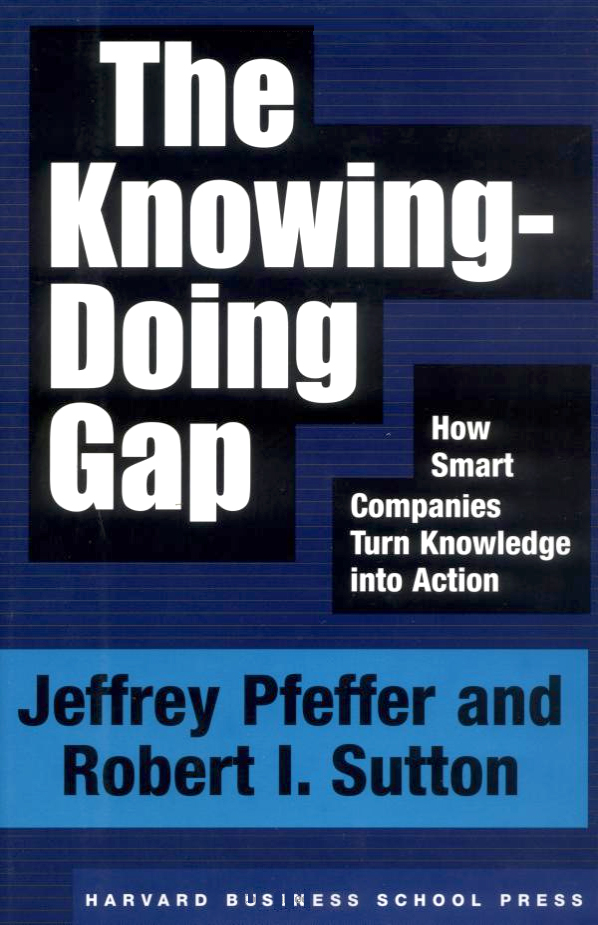The Knowing-Doing Gap
 Buy the Book: Amazon, Barnes & Noble, 800ceoread
Buy the Book: Amazon, Barnes & Noble, 800ceoreadTitle: The Knowing-Doing Gap: How Smart Companies Turn Knowledge into Action
Published by: Harvard Business School Press
Release Date: January 15, 2000
Pages: 336
ISBN13: 978-1578511242
Overview
The so-called knowledge advantage doesn’t exist—even though companies pour billions of dollars into training programs, consultants, and executive education. Although knowledge is important, most companies know, or can readily know, the same things. Moreover, even as companies talk about the importance of learning, intellectual capital, and knowledge management, they frequently fail to take the important next step of turning knowledge into action. This book confronts the paradox of companies that know too much and do too little by showing the barriers to turning knowledge into action and how some companies successfully surmount these obstacles.
Firms that turn knowledge into action avoid the “smart talk trap.” Executive should use plans, analysis, meetings, and presentations to inspire deeds, not as substitutes for doing anything. Companies that act on their knowledge also eliminate fear, abolish destructive internal competition, measures what matters, and promote leaders who understand the work people actually do.
Using examples from dozens of firms, The Knowing-Doing Gap shows how some companies overcome the disconnect between knowledge and action, why others try but fail, and how still others avoid the problem in the first place.
Praise
“The Knowing-Doing Gap is must reading for us all. Why don’t organizations do more of what they already know they should do? The answer isn’t lack of smart or strategy. Pfeffer and Sutton’s analysis of the companies that get it right is fascinating and right on the money. Now…will we take action?”
—Bob Waterman, Co-author of In Search of Excellence and Author of What America Does Right
“The Internet economy is not simply an evolution in technology—it’s a revolution. The Knowing-Doing Gap will help businesspeople apply their expertise in ways that are well suited for succeeding in this new economy.”
—John Chambers, President and CEO, Cisco Systems, Inc.
“Finally, a book that provides valuable insight into the question, ‘Why do most companies know what to do but so few actually do it?’ It’s not so much about strategy, explain the authors; it’s all about execution. Thank you, Pfeffer and Sutton!”
—Richard M. Kovacevich, President and Chief Executive Officer, Wells Fargo & Company
“The Knowing-Doing Gap reveals the major obstacles to action that confront people in organizations—from CEOs to entry-level professionals. The authors guide practitioners through the labyrinth of organizational roadblocks and help them turn knowledge into action.”
—Deborah Coleman, CEO, Merix Corporation
“Pfeffer and Sutton expose the real reasons businesses fail to compete successfully. The Knowing-Doing Gap is a refreshingly clear guide for turning the learning organization into a doing organization.”
—Howard Behar, President, Starbucks Coffee International
Backstory
After writing The Human Equation about how to manage people for competitive advantage, I would give talks on this material about how to build a high-performance culture. After one such talk, a person walked up to me to tell me that although he had enjoyed the talk, the material was all common sense and he already knew it. At which point I asked him if he or his company implemented what he had learned. The answer, “No, of course not.”
That got me to thinking that organizations “knew” a lot but often didn’t put their knowledge into action—there was a gap between knowing what to do and actually implementing that knowledge. So I enlisted my friend and colleague Bob Sutton to explore this issue. Off we went to do case studies of companies such as General Motors that had developed Saturn and gone into the joint venture, NUMMI, with Toyota to learn how to build better cars more effectively but then had failed to transfer that knowledge into the rest of the company. And GM was not alone in its problems of turning knowledge into action.
This book represents our best diagnosis of the causes of the knowing-doing gap and how to overcome the frequently-observed difficulty in turning knowledge into action.